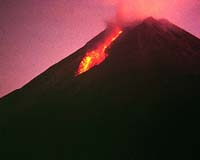| . |  |
. |
Yogyakarta, Indonesia (AFP) Nov 9, 2010 Rescuers in Indonesia voiced fears Tuesday for missing children lost in the chaos of a mass exodus after a series of killer eruptions from the nation's most dangerous volcano. About 320,000 people are living in cramped temporary shelters after being ordered to evacuate from a 20-kilometre "danger zone" around Mount Merapi, which has been spewing ash and heat clouds since late October. "We're concerned about children who are yet to be united with their parents," said Makbul Mubarak, a coordinator for volunteers who are trying to reunite separated families. Tens of thousands of people fled their homes in the central island of Java after Friday's powerful eruption, the biggest at Mount Merapi since the 1870s. Hundreds were still searching for their loved ones, Mubarak said. A total of 151 people have lost their lives since Merapi began erupting again on October 26, with bodies still being pulled from the sludge that incinerated villages on Friday. Fast-flowing torrents of boiling hot gas and rock killed people in their sleep on Friday, leaving smouldering ruins full of bodies. An 5.4-magnitude earthquake rattled the area on Tuesday afternoon, sparking fresh panic and rekindling memories of a deadly quake in Yogyakarta in 2006, but there were no reports of damage. "My parents and I ran out of the house. I was scared because I'm still traumatised by the big quake that occurred here in 2006," said Deru Waskita, 33, a resident of Bantul south of Yogyakarta. The US Geological Survey said the epicentre of the quake was 94 kilometres (58 miles) southwest of Yogyakarta, the historic capital of central Java province. Government volcanologist Surono said Mount Merapi, which means "Mountain of Fire," was still belching heat clouds on Tuesday but not as intensely as on previous days. "The intensity of the eruption has decreased since yesterday but the volcano's activity is still high, its status is still alert," he said. Officials added another 40,000 to the overnight number of evacuees, as more and more people left their villages in the danger zone and joined those in temporary shelters. "We predict the total number of refugees will keep on increasing," disaster management agency official Furqon said. But agency spokesman Sutopo Purwo Nugroho denied rumours that large numbers of people were fleeing Central Java's historic provincial capital Yogyakarta, which lies 26 kilometres south of the volcano. "We haven't seen a large number of people fleeing the city of Yogyakarta so far," he said. The Indonesian archipelago has dozens of active volcanoes and straddles major tectonic fault lines between the Pacific and Indian oceans. The mainly Muslim country is also dealing with the aftermath of a tsunami which smashed into villages on the remote Mentawai island chain, off the coast of western Sumatra, on October 25, killing over 400 people. International flights to Jakarta returned to normal on Monday but ash from Merapi was keeping the airport at Yogyakarta closed, along with tourist sites like the World Heritage-listed Borobudur temple in Central Java. US President Barack Obama is flying into Jakarta later Tuesday, while Austrian President Heinz Fischer arrived earlier on another state visit. Diplomats said Fischer's plane touched down without incident. Airlines cancelled eight flights on Sunday and 36 flights on Saturday, echoing disruption in Europe in April and May when ash from an Icelandic volcano caused global transport chaos. Borobudur caretaker Iskandar said there were concerns that ash from Merapi could damage the 9th-century Buddhist temple mountain, Indonesia's most visited tourist site which lies about 40 kilometres southwest of the volcano. A layer of grey soot about two centimetres (one inch) thick covered the temple after Friday's massive eruption.
Share This Article With Planet Earth
Related Links Bringing Order To A World Of Disasters When the Earth Quakes A world of storm and tempest
 Volcanoes Have Shifted Asian Rainfall
Volcanoes Have Shifted Asian RainfallNew York NY (SPX) Nov 08, 2010 Scientists have long known that large volcanic explosions can affect the weather by spewing particles that block solar energy and cool the air. Some suspect that extended "volcanic winters" from gigantic blowups helped kill off dinosaurs and Neanderthals. In the summer following Indonesia's 1815 Tambora eruption, frost wrecked crops as far off as New England, and the 1991 blowout of the Ph ... read more |
|
| The content herein, unless otherwise known to be public domain, are Copyright 1995-2010 - SpaceDaily. AFP and UPI Wire Stories are copyright Agence France-Presse and United Press International. ESA Portal Reports are copyright European Space Agency. All NASA sourced material is public domain. Additional copyrights may apply in whole or part to other bona fide parties. Advertising does not imply endorsement,agreement or approval of any opinions, statements or information provided by SpaceDaily on any Web page published or hosted by SpaceDaily. Privacy Statement |